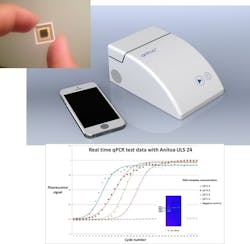Low-light CMOS biosensor enables detection of four copies of pathogen DNA per sample
Anitoa Systems (Palo Alto, CA), in a collaboration with Zhejiang University of China, has demonstrated a handheld, real-time quantitative-polymerase-chain-reaction system (qPCR) using Anitoa's ultra-low-light CMOS biosensor. The company's handheld qPCR can detect several types of pathogen DNA and RNA, including hepatitis B/C and E. coli. It has achieved detection limit of four copies per sample and over nine orders of magnitude in dynamic range.
Related: Infectious disease control with portable CMOS-based diagnostics
A key component of the handheld qPCR system is Anitoa's CMOS biosensor chip. It formed a single-chip fluorescence imaging system, tightly integrated with a miniature thermal cycler, to perform real-time imaging of multiple PCR reaction sites simultaneously without the need for a scanning mechanism commonly used by qPCR systems today.
Released in September 2014, the company's CMOS biosensor has the needed sensitivity to replace photomultiplier tubes (PMTs) and cooled CCDs in a wide range of medical and scientific instruments, such as a qPCR instrument. Its ultra-low-light sensitivity (3e-6 lux) is crucial for achieving good signal-to-noise ratio (SNR) in imaging molecular interactions based on the fluorescence or chemiluminescence signaling principle.
Now, the company is developing a low-cost, portable qPCR-based molecular diagnostics platform as a globally affordable tool to help fight infectious diseases worldwide. By using the company's CMOS biosensor instead of bulkier and more expensive CCD or PMT devices for fluorescence imaging, system designers can now achieve significant space and cost savings by doing away with those auxiliary components found in a PMT- or CCD-based system necessary for signal acquisition, high voltage supply and regulation, and heat ventilation. In addition, multiple CMOS biosensors can be deployed to provide wavelength-multiplexing imaging capability, enabling sensing of multiple reaction sites.
A CMOS-based qPCR reference design that includes a thermal cycler and matching fluorescence imaging subsystem is available from the company for selected OEM customers. Inquiries may be sent to [email protected].
